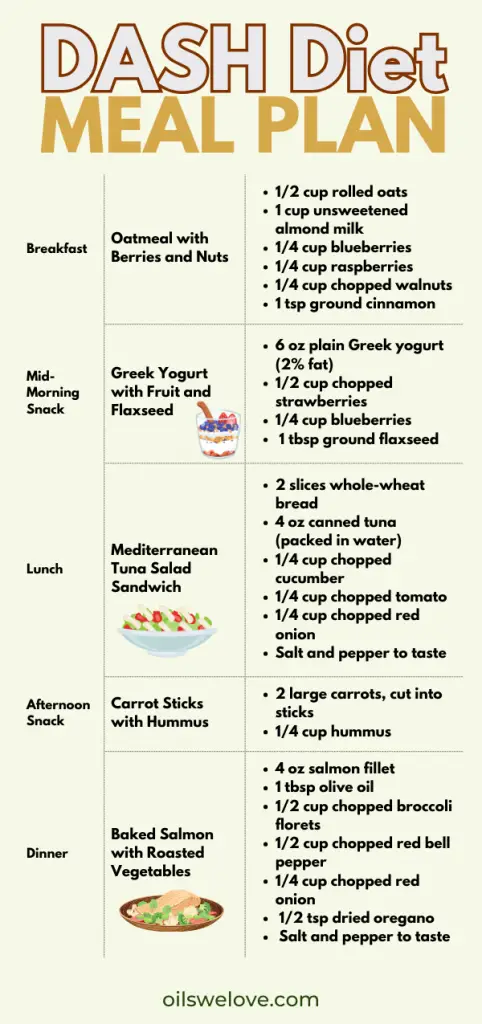The Dietary Approaches to Stop Hypertension (DASH) diet has gained widespread recognition for its effectiveness in lowering blood pressure and improving overall health. If you’re looking to jumpstart your journey to better heart health, here’s how you can get started with the DASH diet.
The core focus of the DASH diet is on consuming nutrient-dense foods that are rich in essential vitamins, minerals, and fiber. By emphasizing whole foods and limiting processed items, this diet aims to reduce sodium intake and promote a balanced and heart-healthy eating pattern.
Key Components of the DASH diet
The DASH diet places a strong emphasis on incorporating a variety of food groups in appropriate portions. To align with the DASH guidelines, your daily diet should include:
- Fruits and Vegetables: Aim for at least 4-5 servings of fruits and 4-5 servings of vegetables per day. These colorful additions provide a plethora of essential vitamins and minerals, along with fiber to support digestive health.
- Whole Grains: Opt for whole grains such as brown rice, quinoa, and whole wheat bread over refined grains. These options offer more fiber and nutrients to keep you feeling full and satisfied.
- Lean Protein Sources: Include lean proteins like fish, poultry, beans, and nuts in your meals to provide essential amino acids and support muscle health.
- Dairy: Choose low-fat or fat-free dairy products to meet your calcium needs while keeping saturated fat in check.
- Limit Sodium and Added Sugars: Be mindful of your sodium intake by reducing the use of salt in cooking and opting for low-sodium alternatives. Additionally, cut back on sugary beverages and snacks to promote better overall health.
Transitioning to the DASH diet may seem daunting at first, but gradual changes can make the process more manageable. Start by incorporating small adjustments, such as adding an extra serving of vegetables to your meals or swapping out sugary snacks for fresh fruit. Gradually increase your intake of whole foods while reducing processed and high-sodium items.

Why you should meal plan on a DASH Diet
Meal planning is a key component of success when following the DASH diet. By preparing nutritious meals in advance, you can ensure that you have healthy options readily available and reduce the temptation to reach for convenience foods. When planning your meals, aim to include a balance of fruits, vegetables, whole grains, lean proteins, and dairy products to meet your nutritional needs. Experiment with new recipes and flavor combinations to keep your meals exciting and satisfying.
With a solid understanding of the principles of the DASH diet and a proactive approach to meal planning, you can set yourself up for success on your journey to improved heart health and overall well-being.

Following the DASH Diet in Daily Life
The key to following the DASH diet successfully is to make small, sustainable changes to your eating habits. Start by focusing on increasing your intake of fruits and vegetables. This doesn’t mean you have to become a full-time vegetarian, but aim to make half of your plate at each meal filled with colorful produce. Snack on fruits and veggies throughout the day to boost your fiber and nutrient intake.
Next, shift your focus to whole grains. Choose whole wheat bread, brown rice, quinoa, and oats over refined grains like white bread and pasta. These whole grains are not only more nutritious but also help keep you full and satisfied for longer periods.
When it comes to protein, opt for lean sources such as poultry, fish, beans, and nuts. Limit your intake of red meat and processed meats, as they are high in saturated fats and can contribute to heart disease. Experiment with plant-based proteins like tofu and tempeh for a tasty and heart-healthy alternative.
Dairy products are another essential component of the DASH diet. Choose low-fat or fat-free options like skim milk, yogurt, and cheese to reduce your intake of saturated fats. If you’re lactose intolerant or prefer plant-based alternatives, look for fortified soy or almond milk to meet your calcium needs.
Finally, don’t forget about fats. While the DASH diet encourages healthy fats like those found in olive oil, avocados, and nuts, it’s important to consume them in moderation. Be mindful of portion sizes and opt for unsaturated fats over saturated and trans fats to support heart health.
Incorporating the principles of the DASH diet into your daily life doesn’t have to be complicated. By making gradual changes to your eating habits and being mindful of your food choices, you can reap the benefits of this heart-healthy diet without feeling overwhelmed. So, start small, stay consistent, and watch your health and well-being flourish.
Benefits of the DASH Diet
Here are some of the key benefits of incorporating the DASH diet into your lifestyle:
Incorporating the DASH diet into your routine can also lead to weight management and improved digestion. The emphasis on whole foods rich in fiber helps promote feelings of fullness, which can prevent overeating and aid in weight loss or maintenance. Furthermore, the high fiber content of the DASH diet supports healthy digestion and can alleviate common gastrointestinal issues like constipation.
Another notable benefit of the DASH diet is its focus on promoting long-term sustainability. Unlike fad diets that often result in short-term success followed by rapid weight regain, the DASH diet encourages a balanced and realistic approach to eating. By incorporating a variety of nutrient-dense foods and promoting mindful eating habits, individuals can develop a sustainable lifestyle that supports their overall health and well-being.
In conclusion, the DASH diet offers a multitude of benefits that extend far beyond just lowering blood pressure. By prioritizing heart-healthy foods, promoting weight management, and encouraging sustainable eating habits, this award-winning eating plan has the potential to transform your health and improve your quality of life. Embrace the DASH diet and discover the numerous advantages it can bring to your overall well-being.




